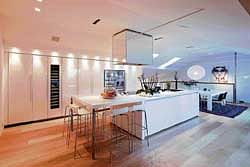Urban hayloft in Stockholm

For Dr Sandberg, 53, a pediatric orthopedist, that meant at the very least finding a home without a yard requiring constant maintenance. But more than that, it meant starting from scratch in the most basic sense: with an unfinished space where they could realise their own vision of an urban loft.
That way, said Lotta Sandberg, 47, a supervisor of public preschools, “we could be a part of designing exactly what we wanted – that was more attractive to us than buying something that was already finished.”
It also turned out to be far more difficult. The raw space they bought in 2002 for 5.2 million Swedish kronor (about $750,000) had great potential: a cavernous apartment in the Vasastan neighbourhood just north of the crowded city centre. It had been built in the 19th century as a hayloft for a stable that housed the city’s street-cleaning horses.
But a couple of years after buying it, the Sandbergs had spent $145,000, hired and fired two architects and still didn’t even have a floor plan.
Tired and frustrated, they were on the verge of giving up when Lotta Sandberg met Bitte Granlund, an interior designer who worked out at her gym.
The two shared a personal trainer and, they soon discovered, similar tastes in design.
Granlund, an owner of a Stockholm firm called Geco, agreed to help them draw up the floor plans and supervise the renovation.
She also helped them secure approval from the various municipal boards that had to sign off on the design, since the building is designated as culturally significant.
Construction began in 2006, with Lennart Sandberg as the project manager, stopping by the apartment before and after work.
“I was here every day – morning and night – for a year and a half,” he said. As far as he is concerned, though, it was worth the effort.
The extensive renovations, which cost about $2.5 million, transformed the space completely, into a modern loft. The only sign of its former function is the bust of a horse that hangs above a gate outside.
First, the nearly 2,800-square-foot space was subdivided into two apartments: a larger one that is the Sandbergs’ primary residence and a smaller one they rent out. With 23-foot ceilings, there was room to install a second floor, which added 1,000 square feet of living space to the main apartment.
That floor became a kitchen and dining area opening onto a covered rooftop terrace. (Because no changes to the facade were permitted by law, the terrace was built into the roof.) Connecting the kitchen and dining area with the living room and the two bedrooms on the lower level are a spiral staircase and a small elevator – the latter dictated by disability regulations that require all new apartments in Sweden to provide wheelchair access to essential rooms like kitchens, bedrooms and bathrooms.
Throughout the apartment, furnishings are minimal and mostly white, which provides a backdrop for the Sandbergs’ art collection.
The spare aesthetic suits the couple, who did not bring any furniture with them from the suburbs when they finally moved into the apartment two years ago.
“We felt like we didn’t want so much stuff in our home,” Lotta Sandberg said. “It’s calming to come home and simply find your favourite things.”
Deccan Herald is on WhatsApp Channels| Join now for Breaking News & Editor's Picks